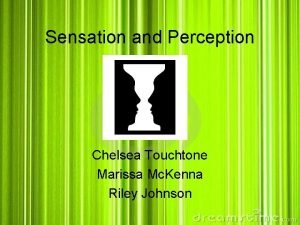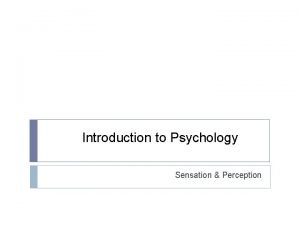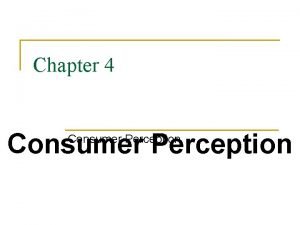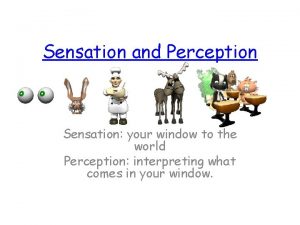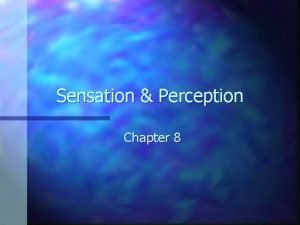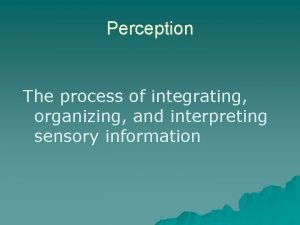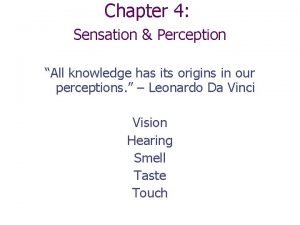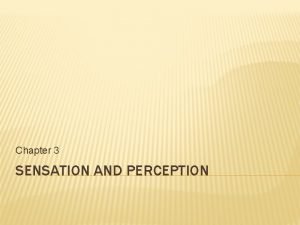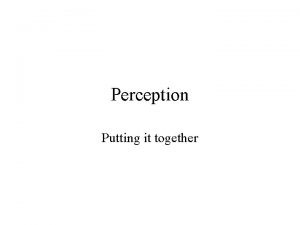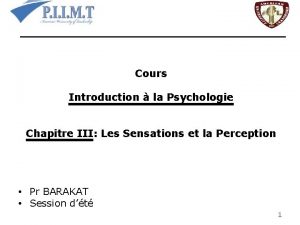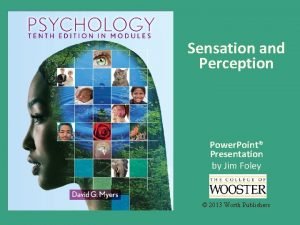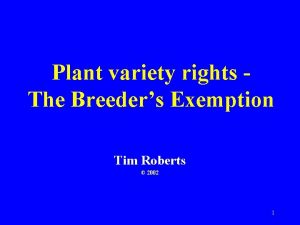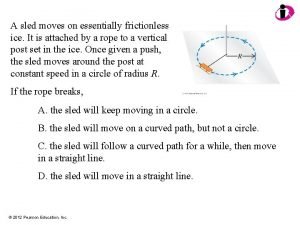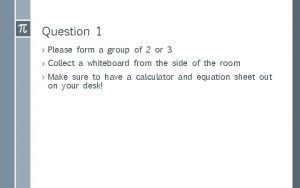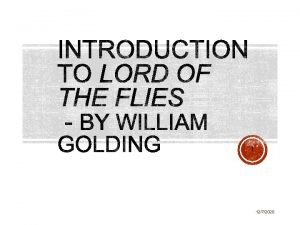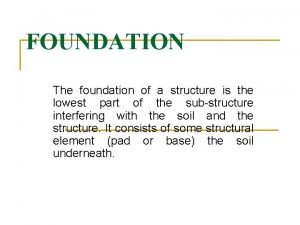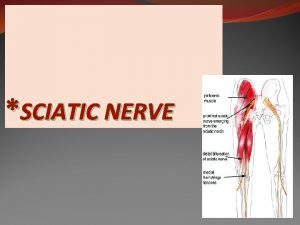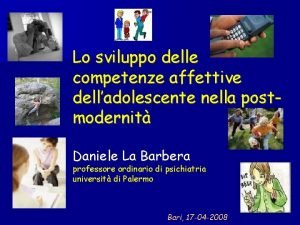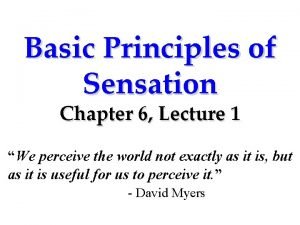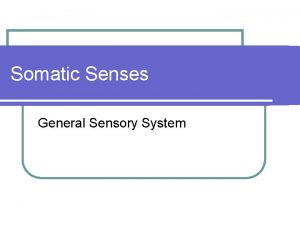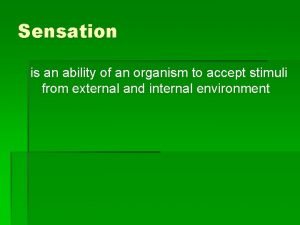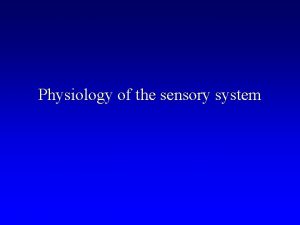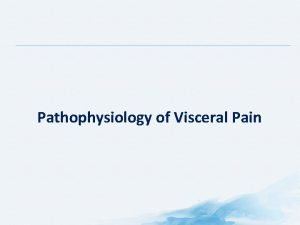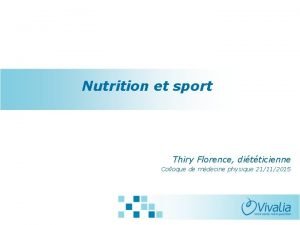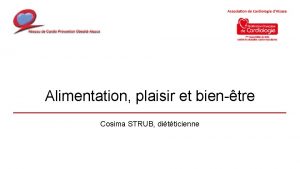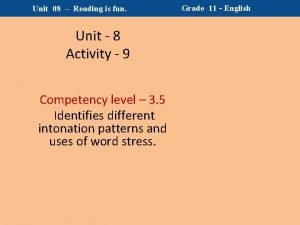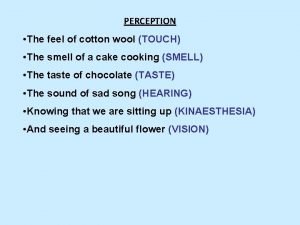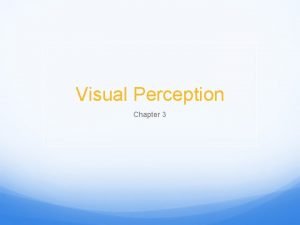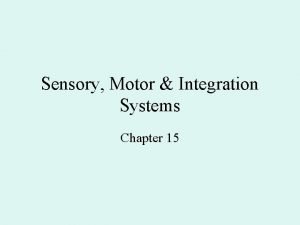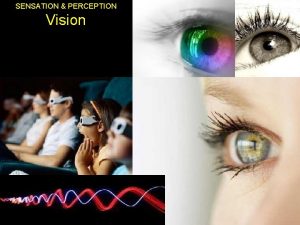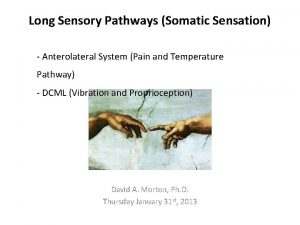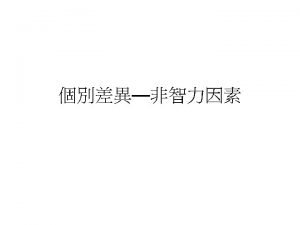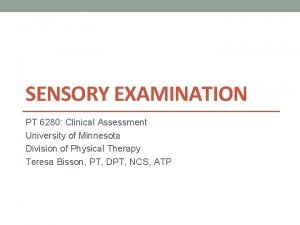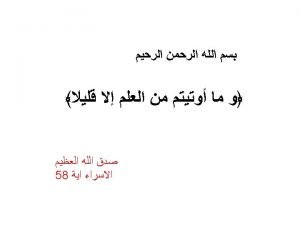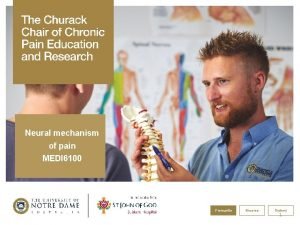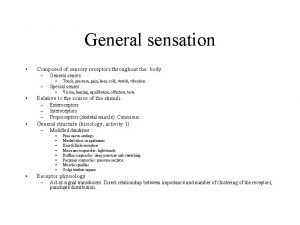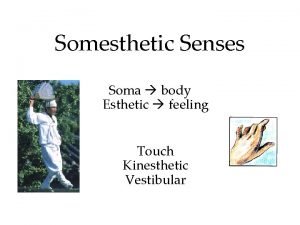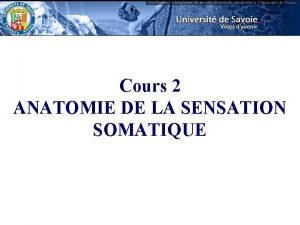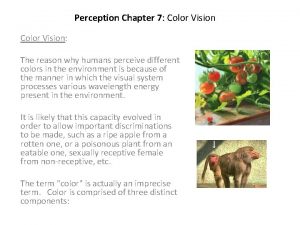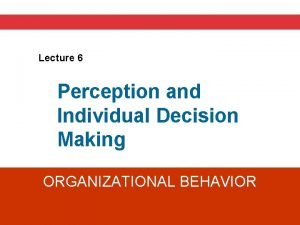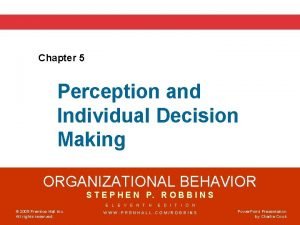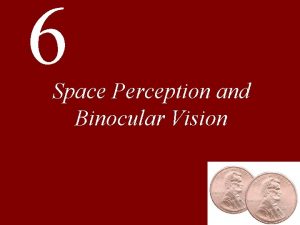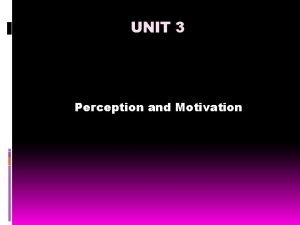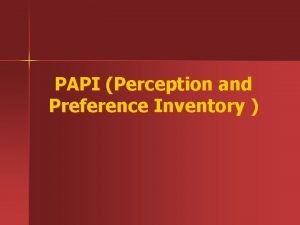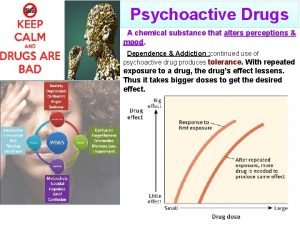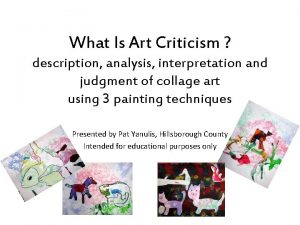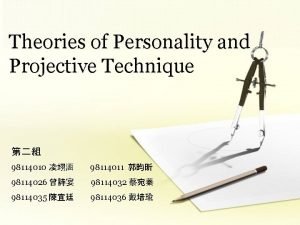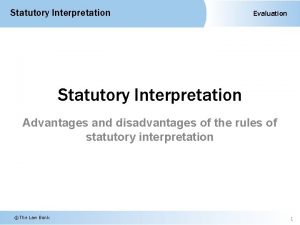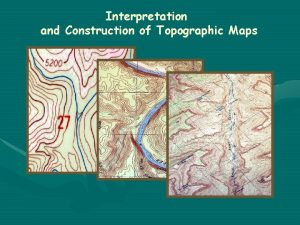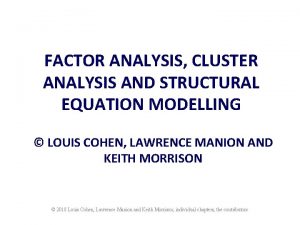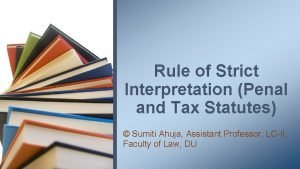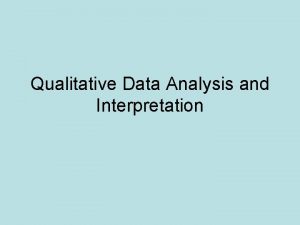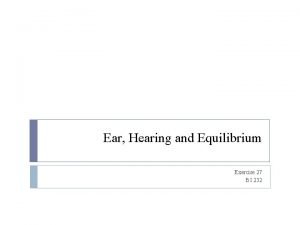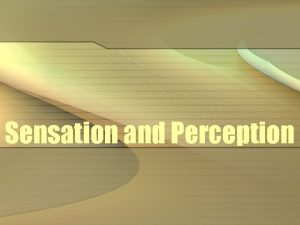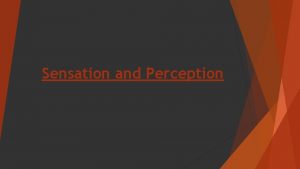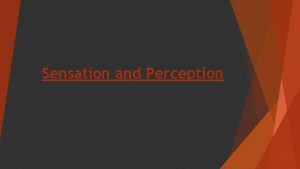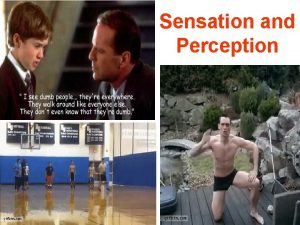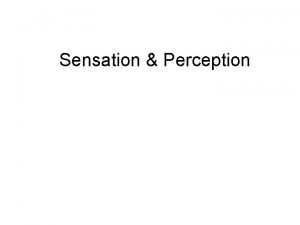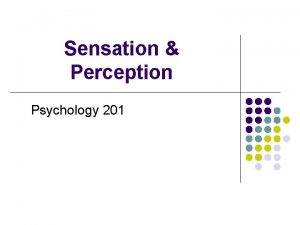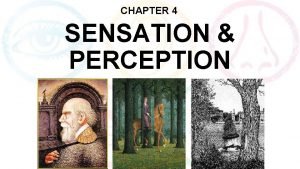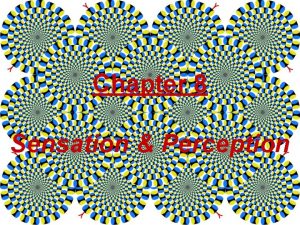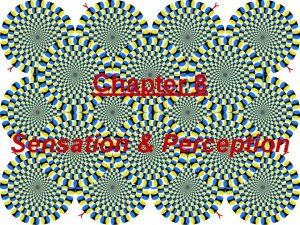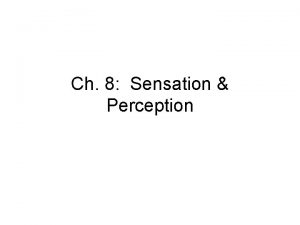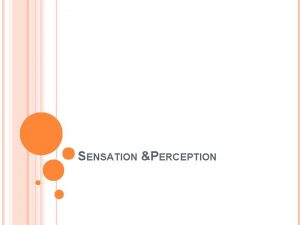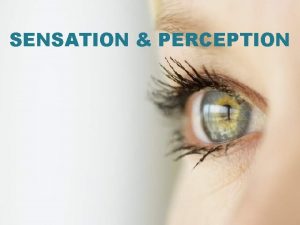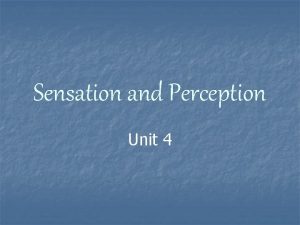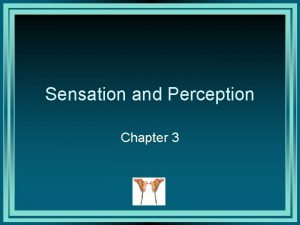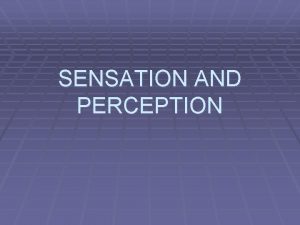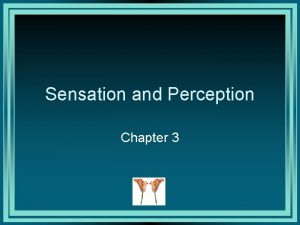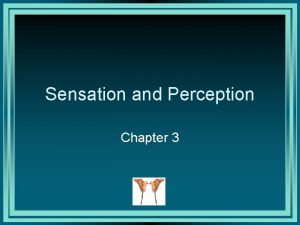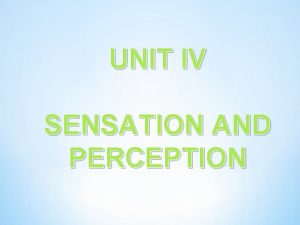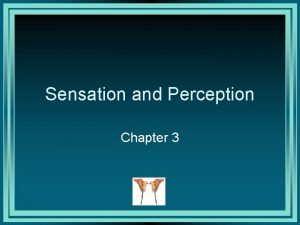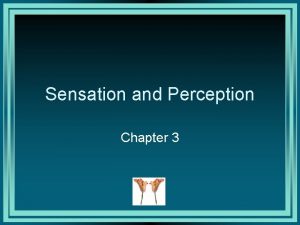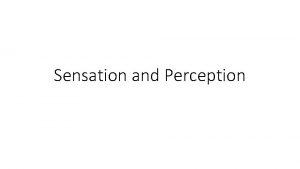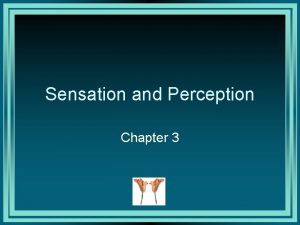Sensation and Perception Perception is essentially an interpretation













































































- Slides: 77

Sensation and Perception • Perception is essentially an interpretation and elaboration of sensation. Therefore, sensation refers to the initial steps in the processing of a stimulus. These pictures look fairly similar

The True Picture

Big Idea • Although it seems the brain interacts directly with the outside world, it does not. • The brain senses the world indirectly because the sense organs convert stimulation into the language of the nervous system: neural messages. ▫ In short, the brain never receives stimulation directly from the outside world.

Transduction: Changing Stimulus to Sensation • In all the sense organs, it is the job of sensory receptors to convert incoming stimuli information into electrochemical signals— neural activity. • Transduction: The sensory process that converts energy, such as light or sound waves, into the form of neural messages. Transduction with Hearing

• The neural impulse carries a code of the sensory event in a form that can be further processed by the brain. Light Waves Neural Signals

The Process of Transduction • Transduction begins with the detection by a sensory neuron of a physical stimulus. • When the appropriate stimulus reaches the sense organ, it activates specialized neurons called receptors. • The receptors respond by converting their excitation into a nerve signal. ▫ Think of this as the way a bar-code reader converts a series of lines into an electrical signal that a computer can match with a price.


A Simple Example • Close both of your eyes. Press gently in the corner of one eye. You should “see” a pattern caused by pressure of your finger, not by light. • These light sensations are phosphenes, or visual images caused by fooling your visual system into thinking it sees light.

Sensory Adaptation • Sensation is critically influenced by change. Thus, our sense organs are change detectors. • Their receptors specialize in gathering information about new and changing events.

Sensory Adaptation • Sensory adaptation is the diminishing responsiveness of our sensory systems to prolonged stimulation. • Unless it is quite intense or painful, stimulation that persists without change in intensity usually shifts to the background of our awareness. ▫ Until now, many of you are probably unaware that your sense of touch had adapted to the pressure of the chair against your legs.

• Because there is a fuzzy line between detection and nondetection, a person’s absolute threshold is not necessarily absolute. • It varies continually with our mental alertness and physical condition Sense Modality Detection of Threshold Light A candle flame at 30 miles on a dark, clear night. Sound The tick of a mechanical watch under quiet conditions at 20 feet. Taste One teaspoon of sugar in two gallons of water. Smell One drop of perfume diffused into the entire volume of a three-bedroom apartment. Touch The wing of a bee falling on your cheek from a distance of one centimeter.


Subliminal Persuasion • Advertising executive James Vicary announced that he had discovered an irresistible sales technique called “subliminal advertisement. ” • He said he could present images so quickly that the conscious mind would not perceive them, but the unconscious mind would, and the images would work on the viewer’s desires unnoticed. • As to be expected, the public was outraged, but fascinated. People began worrying that they were being manipulated by powerful psychological forces. ▫ Lets try it now!!!!

A_ _OM_BI_E

Do Subliminal Messages Work? • Based on studies, some people do respond to stimuli below the absolute threshold, under some circumstances. 100 75 Percentage of correct 50 detections Subliminal stimuli 25 0 Low Medium Absolute threshold Intensity of stimulus ▫ The problem is people behave different thresholds at different levels, so what could be subliminal (or below the threshold) for one person, may be supraliminal (above threshold) for another person.

Backmasking- More Subliminal Messaging? Listing to Songs in Reverse • There are legend about hidden messages in songs. Led Zeppelin's Stairway to Heaven was one of the first songs to have supposed hidden, satanic messages. ▫ http: //jeffmilner. com/backmasking. htm • Why does this seem to work?

The Fovea • The fovea is the area of sharpest vision. • It has the highest concentration of rods and cones.

The Visual Cortex • In the visual cortex, the brain begins working by transforming neural impulses into visual sensations of color, form, boundary and movement. • This process is called parallel processing-simultaneous processing of several aspects of a problem simultaneously

• Different parts of the visual cortex are used to identify different images

After Images • Stare at the eye of the red parrot while you slowly count to 20, then immediately look at one spot in the empty birdcage. The faint, ghostly image of a blue-green bird should appear in the cage.

Explanation of Ghostly After Images • The ghostly birds are called afterimages. ▫ As you stare at the red bird, light-sensitive cells at the back of your eyes become less responsive to red light. This is called the opponent processing theory. Opponent Processing Theory: there are some color combinations that we never see, such as reddish-green or yellowish-blue. ▫ Color perception is controlled by the activity of two opponent systems; a blue-yellow mechanism and a red-green mechanism When you shift your gaze to the birdcage, your visual system “subtracts” red light from the white light that’s being reflected from the white background. White light minus red light is bluegreen light.

Continued Processing • With further processing, the cortex combines these sensations with memories, motives, emotions, and sensations to create a visual world.

A Colorless World • Despite the way the world appears, color does not exist outside the brain, because color is a sensation that the brain creates based on the wavelength of light striking our eyes. • Color is created when the wavelength in a beam of light is recorded by the photoreceptors in the form of neural impulses. • It is then sent to specific regions of the brain for processing.

Color Blindness • Not everyone sees color in the same way, because some people are born with a color deficiency. • While some people can see no color at all, and are totally color blind, it is rare. ▫ More common is color weakness, where people have a hard time distinguishing between certain colors.

The Visual Pathway

Hearing • The vibrational energy of vibrating objects, such as guitar strings, transfer the surrounding medium-air-as the vibrating objects push the molecules of the medium back and forth. • In space, there is no air, so the sound wave would have no medium to push. Any explosion would be eerily without sound.

Frequency and Amplitude • There are two physical characteristics of sound: frequency and amplitude. ▫ Frequency: The number of cycles completed by a wave in a given amount of time-determines pitch. ▫ Amplitude: The physical strength of a wave-the “volume” of the sound.

The Process of Hearing • The middle ear transmits the eardrum’s vibrations through a “piston” made of 3 small bones (the hammer, anvil and stirrup) to the cochlea (snail shaped tube). • The incoming vibrations cause the cochlea’s membrane (oval window) to vibrate, moving the fluid that fills the tube. This motion causes ripples in the basilar membrane (hair cells). • The movement of cells triggers impulses in the adjacent nerve fibers which from the auditory nerve that connects via the thalamus to the temporal lobe.

see pages 126127 for more info

Audition § Place Theory § theory that links the pitch we hear with the place where the cochlea’s membrane is stimulated § Frequency Theory § theory that the rate of nerve impulses traveling up the auditory nerve matches the frequency of a tone, thus enabling us to sense its pitch

How We Locate Sounds

If a tree falls in the forest… • The question “If a tree falls in the forest and there is no one around to hear it, does it still make a sound? ” can now be answered. • No, it would make no noise. • Sound is a purely psychological sensation that requires an ear (and the rest of the auditory system) to produce it.

Deafness • There are generally two types of deafness. • Conduction deafness is an inability to hear, resulting from damage to the structures of the middle or inner ear. • Nerve deafness (Sensorineural Deafness) is an inability to hear, linked to a deficit in the body’s ability to transmit impulses from the cochlea to the brain.

Position and Movement • There are two physical mechanisms that keep track of body position. • Vestibular sense: The sense of body orientation with respect to gravity ▫ The receptors for this information are tiny hairs in the semicircular canal of the inner ear. Vestibular System

Position and Movement • The kinesthetic sense keeps track of body parts, relative to each other. ▫ Kinesthesis provides constant sensory feedback about what the muscles in your body are doing. • Receptors for kinesthesis reside in joints, muscles and tendons. These receptors are usually automatic, unless the person is learning a new skill.

Smell • The sense of smell is olfaction. • Odors first interact with receptor proteins associated with hairs in the nose. • The hairs convey information to the brains olfactory bulbs, located on the underside of the brain. ▫ In humans, olfaction has a close connection with memory. ▫ Certain smells, such as a favorite perfume, can evoke emotionladen memories.

Taste • The sense of taste is gustation. • Human taste has four main qualities: sweet, sour, bitter and salty. • Specialized nerves carry nothing but the taste messages to the brain. There taste is realized on a specialized region of the parietal lobe’s somatosensory cortex.

Taste • Taste receptors can be easily damaged by alcohol, smoke, acids or hot foods. • Fortunately, gustatory receptors are frequently replaced.

The Skin Senses • Skin senses are also connected to the somatosensory cortex. • The skin’s sensitivity to stimulation varies tremendously over the body, depending on the number of receptors in each area.

Gate-Control Theory • Gate-control theory: An explanation for pain control that proposes we have a neural “gate” that can, under some circumstances, block incoming pain. ▫ Pain is sensed by two different sensory pathways, one moving very fast, one moving slower. ▫ The level of pain one feels results from the combination of information from both pathways.

Gate-Control Theory • Ultimately, pain signals are routed to the anterior cingulate cortex located along the fissure separating the frontal lobes. ▫ Pain medication works by blocking the faster of the two neural pathways.

Perception Chapter 4

Perception • Perception: A mental process that elaborates and assigns meaning to the incoming sensory patterns. ▫ Perception brings meaning to sensation. It produces an interpretation of the world, but it isn’t a perfect representation.

Feature Detectors • Our brains have specialized cells whose job it is to identify specific features of a stimuli. • We do not know how the brain combines these features to make a single percept. This problem is known as the binding problem.

Bottom-Up and Top-Down • Bottom-Up processing: Analysis that emphasizes the characteristics of the stimuli rather than our concepts and expectations. • Top-Down perception: Analysis that emphasizes the perceiver’s expectations, concept memories and other cognitive factors, rather than individual characteristics.

Describe This Picture The Forest Has Eyes by Bev Doolittle • Bottom-Up: Lines, angles and colors…a guy riding a horse through the forest • Top-Down: We consider the title and direct our attention to aspects that will give meaning to it.

Perceptual Consistency • The ability to recognize the same object as remaining “constant” under changing conditions is called perceptual consistency. ▫ There are three examples of perceptual consistency including size (different distances), color (different lighting) and shape (different angles).

Illusions • Sometimes your mind will play a trick on you and interprets a stimulus incorrectly. • When your mind interprets an image that is demonstrably incorrect, it is called an illusion. Lets look at an illusion!

The Hermann Grid • Stare at the center of grid. Note how dark fuzzy spots appear at the intersections of the white bars. • Now focus on the intersections, there are no spots. • Why does this illusion exist?

The Answer • The reason for this illusion lies in the way the receptor cells in your visual pathway interact with each other. • The firing of certain cells that are sensitive to light-dark boundaries inhibits other cells that would detect the white lines. This blocking process makes you sense darker regions.

Other Illusions at the Perceptual Level Ebbinghaus Illusion Poggendorf Illusion Zollner Illusion Muller-Lyer Illusion

How Many Faces Do You See?

More Illusions at the Perceptual Level

Muller-Lyer Illusion • One theory for why this illusion exists is that we unconsciously interpret the lines as 3 D images. We see the ends as angles that point toward us or away from us. Therefore, we judge the outside corner to be closer and shorter. • But what if you lived in a culture that had no squarecornered buildings? Muller-Lyer Illusion

Perceptual Organization-Muller. Lyer Illusion

The Zulus • This questions was addressed in the 1970 s when scientists took this image to South Africa and the Zulu people who live in a rounded culture. • Almost exclusively, the Zulu perceived the lines as being the same size. ▫ What does this lead us to conclude about perception? (Hint: learned or inherited? )

The Gestalt Theory • Gestalt Psychologists argue that the brain forms a perceptual whole that is more than the mere sum of its sensory parts.

Pre-wired • Humans see a square as a single figure rather than four lines. • Psychologists argue that examples like this show that humans organize sensory information into meaningful patters. The most basic of these patterns are pre-wired into our brains at birth.

Figure and Ground • Gestalt Psychology divides perceptual experience into figure and ground. • Figure: The part of a pattern that commands attention…stands out. • Ground: The part of the pattern that does not command attention…background.

Closure: Filling in the Blanks • Our minds to a funny thing. They provide closure. That is, they make us see incomplete images as wholes by supplying the missing segments or filling in gaps. • Generally, humans have a natural tendency to perceive stimuli as compete and balanced even when the pieces are missing.

What shapes do you see in each image?

Law of Perceptual Grouping • Law of Similarity: The Gestalt principle that we tend to group similar objects together in our perceptions. Do you see rows or columns? x x x x x o o o o o x x x

Law of Perceptual Grouping • Law of Proximity: The Gestalt principle that we tend to group objects together when they are near each other. Do you see 5 Xs and 5 Os, or 5 pairs of Xs and Os? XO XO XO

Law of Perceptual Grouping • Law of Continuity: The Gestalt principle that we prefer percepts of connected and continuous figures to disconnected and disjointed ones. Are these two continuous lines, or do they have breaks?

Law of Perceptual Grouping • Law of Common Fate: The Gestalt principle that we tend to group similar objects together that share a common motion or destination. ▫ Think a school of fish, a flock of seagulls, a murder of crows

Laws of Perceptual Grouping • Law of Pragnanz: The Gestalt principle which states that the simplest organization, requiring the least cognitive effort, will emerge as the figure. What is wrong with this image?

Context and Expectations • Humans often use context to help interpret out sensations. Once you identify a context, you form expectations about what you are likely to experience. • Context is an enormously useful cue to identify ambiguous stimuli.

Perceptual Set • Perceptual set is a readiness to detect a particular stimulus in a given situation—think of when you are afraid and staying home alone and you notice every noise and think it is a threat. • Here is another example. What is the last word in each line? FOX; OWL; SNAKE; TURKEY; SWAN; D? CK BOB; RAY; DAVE; BILL; TOM; D? CK

Which monster is bigger?

Cultural Influences on Perception • Look at the Ponzo Illusion below. Which line appears longer? A B

Cultural Influences on Perception • To most of us, like “A” looks longer. Psychologist says this may be a result of the culture we have grown up in which includes structures with long parallel lines that seem to converge in the distance. • People who live in cultures without these such lines, like those in Guam see them as the same length. There are no long, straight railroad tracks or roads in Guam.

Cultural Influences on Perception • Research has supported the conclusion that people who live in cultures without long, parallel figures are less likely to report the top line being the longer figure. • These results strongly support the argument that a person’s experiences affect their perceptions.

Perceptual Organization-Depth Perception • Depth Perception ▫ ability to see objects in three dimensions ▫ allows us to judge distance • Binocular cues ▫ retinal disparity images from the two eyes differ closer the object, the larger the disparity ▫ convergence neuromuscular cue two eyes move inward for near objects

Perceptual Organization-Depth Perception • Monocular Cues ▫ relative size smaller image is more distant ▫ interposition closer object blocks distant object ▫ relative clarity hazy object seen as more distant ▫ texture coarse --> close fine --> distant

Perceptual Organization-Depth Perception • Monocular Cues (cont. ) ▫ relative height higher objects seen as more distant ▫ relative motion closer objects seem to move faster ▫ linear perspective parallel lines converge with distance ▫ relative brightness closer objects appear brighter

The End • If you assume your senses give you an accurate and undistorted picture of the world, you are probably wrong. If you don’t believe me, try this. • Silently read the backwards statement below. Flip if over in your mind. What does it say? . rat eht saw tac eh. T

Answer • How many people saw this: The cat saw the rat. • Look at it again: . rat eht saw tac eh. T • How many people saw this: The cat was the rat. • Answer: The cat was the tar.
 Chapter 5 sensation and perception
Chapter 5 sensation and perception Gestalt visual principles
Gestalt visual principles Perceptual set ap psych
Perceptual set ap psych Sensation psychology
Sensation psychology Sensation and perception crossword puzzle
Sensation and perception crossword puzzle Chapter 3 sensation and perception
Chapter 3 sensation and perception Sensation and perception
Sensation and perception Chapter 6 sensation and perception
Chapter 6 sensation and perception Psychology chapter 4 sensation and perception
Psychology chapter 4 sensation and perception Absolute threshold consumer behavior
Absolute threshold consumer behavior Sensation and perception
Sensation and perception Sensation and perception
Sensation and perception Kinesthesis and vestibular sense
Kinesthesis and vestibular sense Sensation perception
Sensation perception Sensation and perception uu
Sensation and perception uu Chapter 4 sensation and perception
Chapter 4 sensation and perception What is sensation
What is sensation Perception vs sensation
Perception vs sensation Exposé sur la sensation en psychologie
Exposé sur la sensation en psychologie Perception vs sensation
Perception vs sensation Face recognition
Face recognition Essentially derived variety
Essentially derived variety What is essentially a structured conversation
What is essentially a structured conversation A sled moves on essentially frictionless ice
A sled moves on essentially frictionless ice A toy car with essentially frictionless
A toy car with essentially frictionless Jean jacques rousseau nature vs nurture
Jean jacques rousseau nature vs nurture Greek mythology background
Greek mythology background Renewable energy sources are essentially inexhaustible
Renewable energy sources are essentially inexhaustible Renewable energy sources are essentially inexhaustible
Renewable energy sources are essentially inexhaustible A grillage foundation is essentially a
A grillage foundation is essentially a A sled moves on essentially frictionless ice
A sled moves on essentially frictionless ice How does interpretation b differ from interpretation a
How does interpretation b differ from interpretation a Sensation seeking
Sensation seeking Sciatic nerve motor or sensory
Sciatic nerve motor or sensory Sensation seeking significato
Sensation seeking significato 6 principles of sensation
6 principles of sensation Thermoreceptors
Thermoreceptors Sensation
Sensation Types of sensation
Types of sensation Does muscle spasms cause burning sensation
Does muscle spasms cause burning sensation Ditticienne base sur coute sensation
Ditticienne base sur coute sensation Ditticienne base sur coute sensation
Ditticienne base sur coute sensation What causes the burning sensation in your muscles
What causes the burning sensation in your muscles Reading 08
Reading 08 Walking on cotton wool sensation
Walking on cotton wool sensation Sensation
Sensation Sensation
Sensation Colour design: theories and applications
Colour design: theories and applications Dcml sensation
Dcml sensation Thinking feeling intuition sensing
Thinking feeling intuition sensing Le dermatomes
Le dermatomes Nociceptive sensation
Nociceptive sensation Pain ascending pathway
Pain ascending pathway Ear sensory
Ear sensory Esthetic feeling
Esthetic feeling Sensation somatique
Sensation somatique Color vision
Color vision Papikostik
Papikostik Perception and individual decision making
Perception and individual decision making Concepts of health and wellbeing
Concepts of health and wellbeing Perception and individual decision making
Perception and individual decision making Subjective perception of vitality and feeling well
Subjective perception of vitality and feeling well Spatial sense in binocular vision
Spatial sense in binocular vision Perception and motivation
Perception and motivation Max martin kostick
Max martin kostick Papi kostick test
Papi kostick test Chemical substance that alters perceptions and moods
Chemical substance that alters perceptions and moods Chapter 7 managing risk vision and perception
Chapter 7 managing risk vision and perception Description analysis
Description analysis Children's apperception test cards ppt
Children's apperception test cards ppt Evolution of computer architecture
Evolution of computer architecture Advantages and disadvantages of purposive approach
Advantages and disadvantages of purposive approach Topographic map interpretation
Topographic map interpretation Kmo test
Kmo test Interpretation and construction
Interpretation and construction Example of analysis and interpretation of data
Example of analysis and interpretation of data Interpretation and construction
Interpretation and construction Weber test
Weber test




